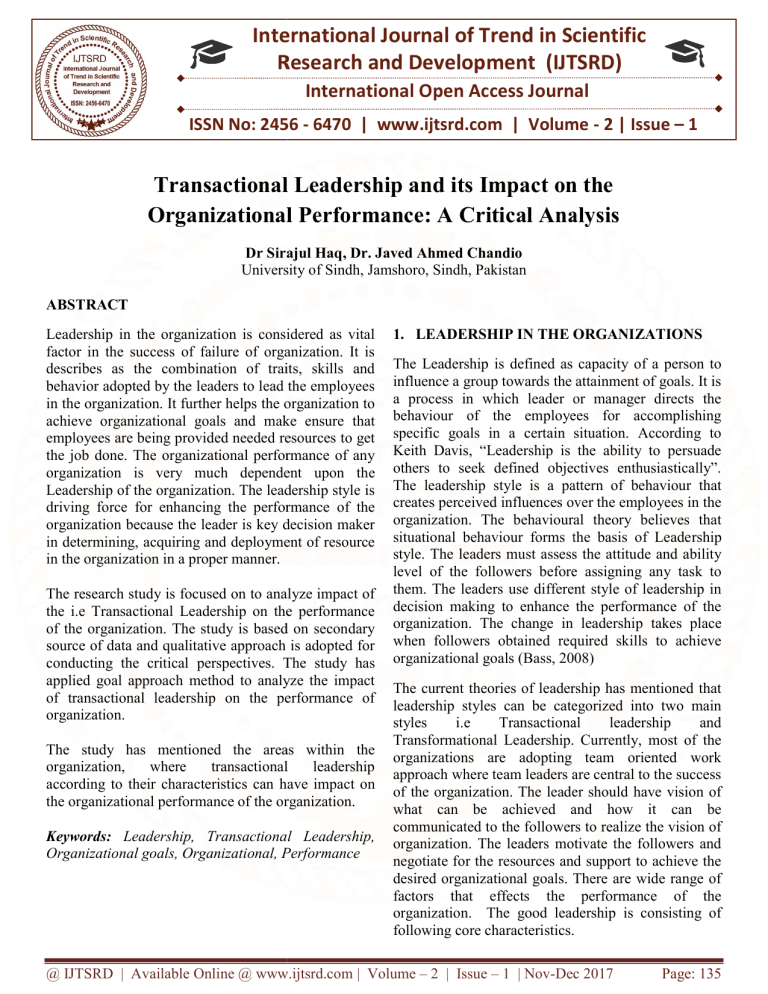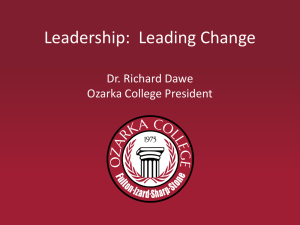
International Journal of Trend in Scientific
Research and Development (IJTSRD)
International Open Access Journal
ISSN No: 2456 - 6470 | www.ijtsrd.com | Volume - 2 | Issue – 1
Transactional Leadership and its Impact
mpact on the
Organizational Performance: A Critical Analysis
Dr Sirajul Haq
Haq, Dr. Javed Ahmed Chandio
University oof Sindh, Jamshoro, Sindh, Pakistan
ABSTRACT
Leadership in the organization is considered as vital
factor in the success of failure of organization. It is
describes as the combination of traits, skills and
behavior adopted by the leaders to lead the employees
in the organization. It further helps the organization to
achieve organizational goals and make ensure that
employees are being provided needed resources to get
the job done. The organizational performance of any
organization is very much dependent upon th
the
Leadership of the organization. The leadership style is
driving force for enhancing the performance of the
organization because the leader is key decision maker
in determining, acquiring and deployment of resource
in the organization in a proper manner.
The research study is focused on to analyze impact of
the i.e Transactional Leadership on the performance
of the organization. The study is based on secondary
source of data and qualitative approach is adopted for
conducting the critical perspectives. The study has
applied goal approach method to analyze the impact
of transactional leadership on the performance of
organization.
The study has mentioned the areas within the
organization,
where
transactional
leadership
according to their characteristics can have impact on
the organizational performance of the organization.
Keywords: Leadership, Transactional Leadership,
Organizational goals, Organizational, Performance
1. LEADERSHIP IN THE ORGANIZATIONS
The Leadership is defined as capacity of a person to
influence a group towards the attainment of goals. It is
a process in which leader or manager directs the
behaviour of the employees for accomplishing
specific goals in a certain situation. According to
Keith Davis, “Leadership is the ability to persuade
others
thers to seek defined objectives enthusiastically”.
The leadership style is a pattern of behaviour that
creates perceived influences over the employees in the
organization. The behavioural theory believes that
situational behaviour forms the basis of Leadership
Leade
style. The leaders must assess the attitude and ability
level of the followers before assigning any task to
them. The leaders use different style of leadership in
decision making to enhance the performance of the
organization. The change in leadership
leadershi takes place
when followers obtained required skills to achieve
organizational goals (Bass, 2008)
The current theories of leadership has mentioned that
leadership styles can be categorized into two main
styles
i.e
Transactional
leadership
and
Transformational
onal Leadership. Currently, most of the
organizations are adopting team oriented work
approach where team leaders are central to the success
of the organization. The leader should have vision of
what can be achieved and how it can be
communicated to the followers
llowers to realize the vision of
organization. The leaders motivate the followers and
negotiate for the resources and support to achieve the
desired organizational goals. There are wide range of
factors that effects the performance of the
organization. Thee good leadership is consisting of
following core characteristics.
@ IJTSRD | Available Online @ www.ijtsrd.com | Volume – 2 | Issue – 1 | Nov-Dec
Dec 2017
Page: 135
International Journal of Trend in Scientific Research and Development (IJTSRD) ISSN: 2456-6470
Competence &
Knowledge
Good Judgement
Leadership
Interpersonal Skills
Confidence
Figure-1 Core Leadership Characteristics
The organizational success is dependent upon the
ability of Leadership as how to achieve organizational
goals. The good leadership always considered the
importance of employees in achieving the
organizational goals. The good leaders must have the
ability of good judgment, possesses confidence,
interpersonal skills and must be a competent and
knowledgeable. The employees of the organization
need to be inspired and stimulated for the
achievement of the organizational mission. The
effective leadership can enable greater participation
employee workforce and enhances organizational
performance (Charry, 2012).
organizational performance. The management of the
organization attribute their success to the leadership
efficiency. The demonstration of leadership style to
care and respect for the employees would increase the
commitment and motivation of employees to put up
their efforts for better performance. The employee
performance enhance the organizational performance.
The study has mentioned that there is significant
relationship between the leadership styles and
organizational performance. It is observed that
effective leadership has substantive impact on the
organizational development and growth of the
organization (Bass, 2008)
The last decade has observed the radicle change in the
organizational environment. The global competition
in the market has forced the organizations to
streamline the business operations to enhance their
organizational performance. The performance of
organization is dependent on the quality of the
workforce at different levels of the organization. The
employees’ performance measured by the degree to
which employees accomplish work requirement. The
employee’s performance reflects the efficiency of the
organization. The research has mentioned that there is
significant relationship between leadership style and
organizational performance. The effective leadership
plays significant role in the development of
management and sustaining competitive advantage
(Hargis,Wayyat & Piotrowski, 2012)
The organizational performance is the capability of
the organization to obtain the set of objectives by
utilizing available resources effectively within the
organization. Generally, organizational performance
is measured in terms of revenue, profit, growth,
development and expansion of the organization. It
includes three primary outcomes i.e, financial
performance, market performance and production
performance. In the case of public organizations, the
performance is measured in terms of efficiency in
delivering the services to the public. The transactional
leadership is bureaucratic in style and it can be found
in business and as well as in public organizations.
This leadership always emphasize on developing
relationship with their followers and more reactive in
decision making of the organization. This leadership
focused on developing existing organization culture
and there in only one leaders in the organization
(Timothy,Andy & Idowu, 2011).
The research studies conducted by Sun Scholar has
compared leadership styles with organizational
performance in enterprises. His research study has
found positive co-relation of leadership style with
@ IJTSRD | Available Online @ www.ijtsrd.com | Volume – 2 | Issue – 1 | Nov-Dec 2017
Page: 136
International Journal of Trend in Scientific Research and Development (IJTSRD) ISSN: 2456-6470
There is no specific agreed criteria to be used in
assessing the organizational performance. However,
the literature study has mentioned four main
approaches used for the assessing the organizational
performance. The first is “Goal Approach”, in the
approach the organizational performance is assessed
in terms of ability of the organization to achieve
organizational goals. The second is “System Resource
Approach” where organization performance is
assessed by exploring the relationship of the
organization with its environment. The third is
“Contingency Approach” where organizational
performance is assessed by perception of multiple
stakeholders as an effective organization. The fourth
is “Competing Value approach” where the
organization performance is assessed by using
different criteria that shows the adaptability,
flexibility and stable organization in the competitive
environment (Karamat, 2013)
As this study is focused on to assess the impact of
transactional leadership on the organizational
performance, therefore, it will apply goal approach
technique to assess the impact of Transactional
leadership on the performance of the organization.
2. Transactional leadership and Organizational
Performance
This Leadership model was introduced by the
Maxweber in 1947. Transactional leadership is a kind
of Managerial Leadership and mostly focused on
organization, supervision and performance of the
employees in the organization. This leadership style
emphasized on the rewards and targets between
employees and management. It focussed on the
performance of employees in the organization and the
employees are rewarded with promotions and
financial awards on the basis of the performance
record of the employees. This leadership style assist
the organization to obtain the objectives based on
efficiency and effectiveness of the employees. This
Leadership believes that employees are motivated by
reward and punishment and employee must obey the
order of the superior and their work closely be
monitored and controlled (Bryant, 2003). The study
has mentioned following characteristics of the
Transactional Leadership model.
Focused on short term
goals
Follow policies and
procedures
Transactional
Leadership
Oppose to change
Revel in efficiency
Figure-2: Transactional Leadership Characteristics
The above figure presents the major characteristics of
Transactional Leadership Model. It shows that
transactional leadership emphasize on short terms
goals, follows policies and procedures, revel in
efficiency but inflexible to changing environment.
This leadership does not provide the opportunity to
their followers to participate in decision making
process of the organization. This type of leadership is
found effective in the decision making which is aimed
at reducing the cost and increase the productivity in
the organization. This leadership assumed that subordinate can be motivated by simply rewards.
The example of Transactional leadership is found
bureaucratic organizations. The bureaucratic leaders
focuses on rules and procedures to manage teams and
projects. It is a style that run a number of departments
or people and there is a strict set of regulations.
People who want to use this style of leadership are
often familiar with the many policies and guidelines.
Transactional Leadership values order and structure of
@ IJTSRD | Available Online @ www.ijtsrd.com | Volume – 2 | Issue – 1 | Nov-Dec 2017
Page: 137
International Journal of Trend in Scientific Research and Development (IJTSRD) ISSN: 2456-6470
the organization. This style of leadership is successful
in military organisations and large corporations but it
is not successful in the organization where creative
and innovative practices are followed. Amongst the
large corporations, Hewlett-Packed Company is well
known for its extensive use of Transaction style of
leadership.
Norman Schwarzkopf, Brigadier General of United
States Army was one of the example of Transactional
leadership. He was commander in chief of the United
States forces in operation desert storm, who was
responsible for tens of thousands of troops in Iraq and
Kuwait. He used military rules and regulations to
execute the operation on several continents. Vince
Lombardi is also a example of Transactional
Leadership. He remained a coach of Green Bay
Packers for Super Bowl team. His leadership led the
team to win five championships. He trained the team
so well that the opponent teams faced troubles to
defend against them. Bill Gates is also a great
example of Transactional Leadership. He is CEO of
Mircosoft Company, who is known as one of richest
person in the world due to his successful achievement
in his business career. As a Transaction leader, he
frequently made the visits to his product teams to
make sure that his team is going on the right direction
to achieve organizational goals (Bernard, 2000). The
following figure mentioned the areas within the
organization that as to how the transactional
leadership can have a impact on the organizational
performance.
Effectiveness and
Effeiciency of the
employee
Employees
Motivation by
reward and
punsihment
Values order and
structure of the
organizatoin
Organizational
Performance
Work is closely
monitored and
controlled
Orders of superiors
must be obyed by the
employees
Follow rules and
regulations
Figure 3: Transactional Leadership’s impact on the organization
The above figure describes that transactional
leadership emphasize on working efficiency of the
employees, maintain the same order and structure of
the organization, follow the rules and regulations,
closely monitor the workings of the employees and
reward the employees who performed well and punish
the employees who performed bad in performing their
assigned tasks.
This leadership style has been successful in the
multinational organizations where the employees do
not speak the same language, same culture and same
race but the leadership approach is understandable
across the organization and employees easily follow
the leadership directions to complete the tasks
successfully. Transactional leadership is simple to
learn and easier to apply in crisis situation where
everyone knows exactly what required tasks are and
how they can be completed under pressure.
CONCLUSION
It is generally obserserved that leadership existed at
the different levels of the organization and its
common goal is to obtain the desired goals of the
organization. It is observed that organizational
performance is totally dependent upon the leadership
of the organization. The study has highlighted core
@ IJTSRD | Available Online @ www.ijtsrd.com | Volume – 2 | Issue – 1 | Nov-Dec 2017
Page: 138
International Journal of Trend in Scientific Research and Development (IJTSRD) ISSN: 2456-6470
characteristics of leadership that good leadership must
possess good judgement, competence and knowledge,
confidence and interpersonal skills.
Analyzing the impact of Transactional leadership on
the performance of the organization, it is concluded
that transactional leadership emphasizes on the
effectiveness and efficiency of the employees, it
values order and structure of the organization,
motivate employees by giving reward and punishment
to the employees, follow strict rules and regulations
and closely monitor the working of the employees in
the organization
This leadership style focused on planning and
execution of the programs and work for improving the
present condition of the organization. It is also
concluded that transactional leadership is bureaucratic
style of leadership and it mostly existed in
bureaucratic form of organizations. This leadership
style is best suited to the settled environment of the
organization.
REFRENCES
1) Karamat (2013). Impact of Leadership on
Organizational Performance A Case Study of
D&R
Cambric
Communication.
Business
Economics and Tourism 2013
2) Charry, K. (2012). Leadership Theories - 8 Major
Leadership Theories. Retrieved February 10, 2017
from
http://psychology.about.com/od/leadership/p/leadt
heories.htm
3) Hargis, M. B., Wyatt, J.D., Piotrowski, C. (2012).
Developing Leaders: Examining the Role of
Transactional and Transformational Leadership
across
Contexts
Business.
Organization
Development Journal 29 (3): 51–66 Hay, I (2012)
4) Timothy C, Andy T, Victoria O and Idowu A
(2011). Effects of leadership style on
organizational performance: a survey of selected
small scale enterprises in ikosi-ketu council
development area of lagos state, Nigeria.
Australian Journal of Business and Management
Research Vol.1 No.7 [100-111].
5) Bass, B. M. (2008). The Bass handbook of
leadership: Theory, research, & managerial
applications (4th ed.). New York, NY: Free Press.
6) Joyce, E.; Judge, Timothy A. (2004). "Personality
and
Transformational
and
Transactional
Leadership: A Meta-Analysis". Journal of Applied
Psychology. 89 (5): 901–910.
7) Bryant, S.E. (2003). The role of transformational
and transactional leadership in creating, sharing
and exploiting organizational knowledge. Journal
of Leadership and Organizational Studies, 9(4),
pp. 32-44.
8) Bernard M.(2000) .,"The Future of Leadership in
Learning Organizations" Journal of Leadership &
Organizational Studies 7.3 (2000): 19-31.
9) Lowe, K. B., Kroeck, K. G., & Sivasubramaniam,
N.
(1996).
Effectiveness
correlates
of
transformational and transactional leadership: A
meta-analytic review. Leadership Quarterly, 7,
385-425.
10) Certo, S. C. (2002). Modern Management, (9th
Ed.). New Delhi: Prentice Hall
11) Den Hertog, D. N., Van Muijen, J. J. & Koopman,
P.
L.
(1997).
Transactional
Versus
Transformational Leadership: An Analysis of the
MLQ. Journal of Occupational and Organisational
Psychology, Vol. 70, pp. 19-34.
12) Sarrows, J. & Woodman, D. (1993). Leadership in
Australia and its Organizational Outcomes.
Leadership and Organizational Development
Journal, Vol. 14. No. 4, pp. 3-9.
13) Paracha, M. U., Qamar, A. Mirza, A. & Waqas, I.
(2012).
Impact
of
Leadership
Style
(Transformational and Transactional Leadership)
on Employee Performance and Mediating Role of
Job Satisfaction Study of Private School
(Educator) in Pakistan. Global Journal of
Management and Business Research. Volume 12
Issue 4 Version 1.0.
14) Bennis W. (2007). The challenge of leadership in
the modern world: introduction to special issues.
Am. Psychol., 62(1), 2-5.
15) Jin .W, Shieh .C & Tang . M. (2011). Effect of
leadership style on organizational performance as
viewed from human resources management
strategy. African journal of business management,
4(18), 3924-3936.
@ IJTSRD | Available Online @ www.ijtsrd.com | Volume – 2 | Issue – 1 | Nov-Dec 2017
Page: 139





